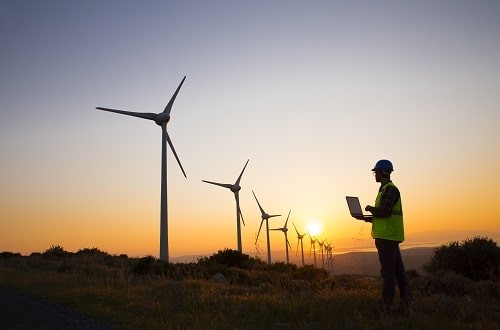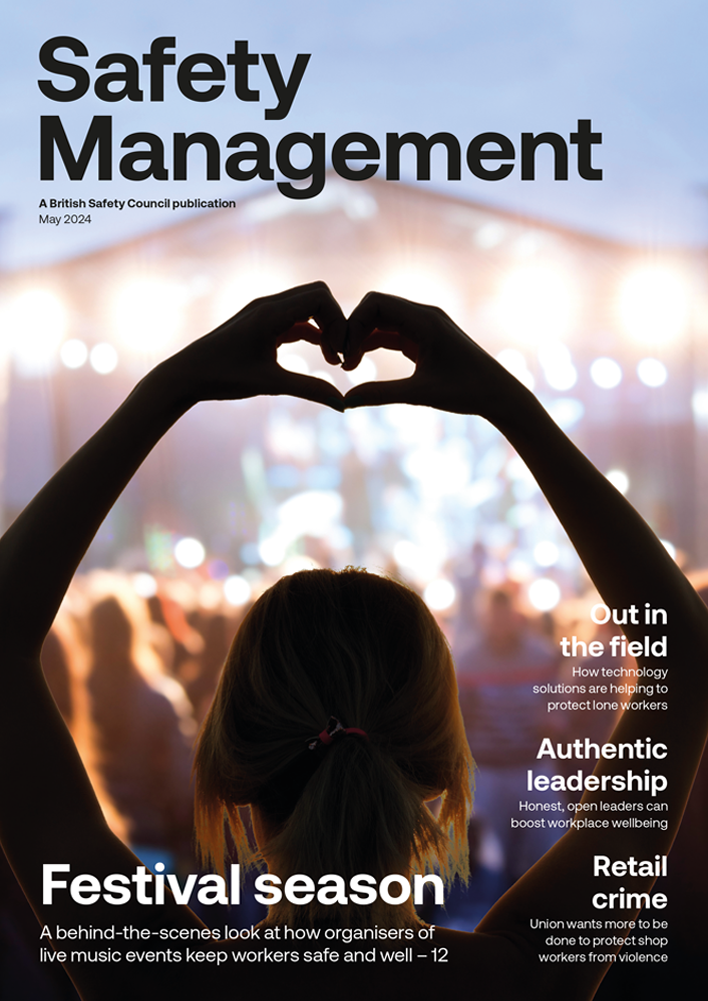People working away from a fixed base out in the field may need to quickly summon assistance in an emergency, but it’s important to choose the right communications and alarm technology for their needs.
Features
Out in the field: why lone worker monitoring is key
Identifying your field-based lone workers
It is estimated that one fifth of the UK’s working population are lone workers, who the Health and Safety Executive (HSE) define as “those who work by themselves without close or direct supervision”. The risk profile of a ‘lone worker’ can vary significantly based on their surroundings and the nature of their work, and so too can the steps necessary to mitigate these risks.
 Photograph: iStock/BulentBaris
Photograph: iStock/BulentBaris
The first step is identifying the type of lone working and therefore the type of risk assessment that should be carried out based on this profile. The HSE has outlined five risk profiles of employees that work alone:
- Working alone at a fixed base (for example, shop, factory, warehouse)
- Working separately from others on the same premises or outside of normal working hours (for example, cleaners, security officers)
- Working away from a fixed base (for example, social workers, sales reps, engineers, HGV drivers)
- Volunteers carrying out work alone on behalf of charities/voluntary organisations
- Working from home.
This article focuses on the health and safety risks to employees working away from a fixed base, known as field-based staff. They are defined as employees who work across different sites and locations, away from an office or their home. They include mobile engineers, surveyors, inspectors and service technicians, through to construction workers and sales representatives.
As an employer, you have a legal duty of care to ensure the appropriate safety measures are put in place to keep these workers safe.
This can be easier said than done when environmental factors come into play for field-based staff and the risk landscape is continually evolving.
The necessary steps to reduce risks
Identify the risks
All organisations that employ people are required by law to carry out a risk assessment to identify any risks to workers’ health and safety and decide how best to eliminate or control those risks. If the business employs five or more people the significant findings of the assessment must also be recorded. A free template risk assessment for working away from a fixed base is available here.
Although an employer does not necessarily need to conduct a separate risk assessment for lone working, the risks arising from all relevant work activities should be assessed through the lens of an employee being alone – for example, does being alone make a health and safety risk more likely or more severe?
For instance, when assessing an engineer working from height, lone working does not make the risk of falling more likely but it does make the risk more severe – as the longer an injured person is left without medical assistance, the more severe the outcome may become.
A risk matrix can be a helpful tool to categorise risks into high, medium and low risk by identifying the risk and then adding a numerical rating (1–5) on how likely the risk is and how severe the impact could be. When the likelihood and the severity are multiplied together, the higher the number, the greater the risk and thus more precautions are likely to be required to mitigate the risk.
It is also important that risk assessments are not created in a vacuum. The most important people to consult in this process are the frontline employees exposed to these risks daily.
The key difference for employees working away from a fixed base is that the employer has little to no control over the environment – for example, a social worker visiting a residence with unknown individuals also possibly visiting the property at the same time, or an engineer visiting a remote site when a storm breaks. With this in mind the employee must have the knowledge to carry out their own dynamic risk assessment.
A dynamic risk assessment means the continuous process of identifying hazards, assessing risk, taking action to eliminate or reduce risk, and monitoring and reviewing, in rapidly changing circumstances.
 Photograph: iStock/DanielBalakov
Photograph: iStock/DanielBalakov
It may therefore be necessary to provide field-based staff with specific training on dynamically assessing risks and this training must be tailored to the nature of their working environment.
Mitigate the risks
Once the risks have been identified and the likelihood and severity of risks has been assessed, employers need to design control measures and safe systems of work for managers and employees, to ensure specific tasks are carried out as safely as possible.
Employers have the same duty to ensure the safety of field-based staff as they do for any member of staff. This means risks must be mitigated to an acceptable level, meaning doing everything ‘reasonably practicable’ to protect people from harm.
Of course, the best option is to completely eliminate the risk if possible – for example, removing the lone working activity completely if it is not essential. However, if this is not possible the risk must be mitigated, as far as reasonably practicable.
It is also essential to draw up a lone working policy that provides essential safety guidance and support to all employees, especially field-based staff. The policy should explain how risks will be mitigated by managers and employees working alone and the systems that must be in place during lone working to ensure employees are kept safe.
If field-based staff are working alone, it may also be appropriate to provide them with lone worker protection technology as one of the measures to reduce the risk of accidents, injuries and emergency situations. The correct use of these solutions should be set out in the lone working policy.
Technology available for field-based employees
When it comes to technology designed to protect vulnerable employees such as lone workers, many people immediately think of solutions like under-desk panic alarms typically found in banks and jewellers. However, for field-based staff this is not an option, and they need mobile protection technology that can protect them away from a fixed base, out in the field.
For some lone workers, the main requirement of a lone worker solution (such as a communication device that allows them to raise the alarm with colleagues or an alarm receiving centre) is to be discreet yet easy to activate – for example, housing officers or mobile salespeople. However, for others the device needs to be capable of providing protection and a way of calling for assistance in areas with poor mobile phone signal (for example, agricultural or forestry workers).
 Rebecca Pick is founder and chief executive of Pick Protection. Photograph: Pick Protection
Rebecca Pick is founder and chief executive of Pick Protection. Photograph: Pick Protection
There is a range of solutions available and at first it can be daunting to narrow down exactly what matches the needs of an organisation’s lone workers. However, a good starting point is to assess which of the three categories of technology meets the workers’ requirements – a smartphone application, a dedicated device or a satellite device.
Smartphone application
Lone worker apps for smartphones are fast becoming the most popular option for protecting vulnerable workers. They’re cost effective, feature-rich and don’t require employees to remember to charge or carry an extra device.
However, just because they’re cheaper this doesn’t mean they offer any less protection. They’re cheaper because they use existing hardware – for example, the GPS location tracking technology, microphone, speaker etc – in the mobile phone.
The typical features included with a lone worker smartphone app include:
- SOS alarm: For use in emergencies, sending the GPS location and opening a two-way audio channel to summon an emergency response
- Proactive timed welfare check: For periods of higher risk, employees can set a timer where they will press a button to confirm their safety at the end of a task. If they do not confirm their safety in a timely manner an alarm is raised automatically
- Pre-alert: A messaging capability for employees to proactively provide information on the task or situation
- Fall detection: This automatically raises the alarm upon an employee falling
- Geofencing: This applies location information to automate certain functions.
If employees are working in remote locations, the employer must ensure they select an application that can utilise Wi-Fi, 2G, 3G, 4G and 5G to maximise connectivity to the mobile phone signal, to ensure workers can easily raise the alarm.
If employees are working in a public-facing role, it may be appropriate to add a discreet Bluetooth-enabled SOS trigger device that connects wirelessly with the lone worker app on their mobile phone. This is a small, long-life battery-powered device designed to be clipped to a keyring, carried as a ‘keyfob’ or attached to a lanyard worn around the neck or at the waist that can be pressed to activate an SOS alarm on the phone’s app without having to touch the phone. This allows workers to quickly and discreetly raise the alarm, without having to launch the phone’s app or hit buttons on it.
Dedicated device
If an employer has a policy that staff should not carry a smartphone at work, or individual workers are reluctant or less inclined to use modern technology such as apps on smartphones, a dedicated communication, monitoring and personal alarm device may be the best option.
Dedicated devices can be worn on a lanyard, enclosed within a belt clip, or held in an arm band or wrist strap. They usually include either standard or roaming SIM packages. A roaming SIM enables the device to connect typically to up to three different cellular communications networks, most commonly on the 2G or 4G networks, while some devices may also include Wi-Fi calling.
The functionality of dedicated devices can vary. Top of the range devices will include all the functionality listed above for smartphone apps, though most will offer different selections of the functionality, so it’s important to decide which functions are most relevant for the specific risk profile of each lone or vulnerable worker. With the most basic level of functionality, the user presses an SOS button on the dedicated device, which automatically connects a call to an alarm receiving centre (ARC) – opening a live ‘phone’ line to the ARC – or sends an alarm message to the ARC. The ARC will also automatically receive a GPS location for the user.
Dependent on the level of usage, a standalone device may require charging every two to five days.
However, employers must remember that when choosing between an app or a device, it is important to choose a solution that employees will be more inclined to use over a long period of time.
Satellite device
The third category of lone worker solution is a satellite device. These are at the top of the price range for lone worker solutions but can provide connectivity in cellular black spots, as the device uses satellite to send communications between the user and the ARC. Typically, satellite devices do not have audio capability but allow an individual to raise an SOS alert and type and send additional information. However, it is important to remember satellite devices only work when they have line of sight to the satellites, so if the user is within a building or dense forest, for instance, the device will not be able to connect.
Whether employees are using an app, dedicated or satellite device, they all have one thing in common – they can be a lifeline in an emergency. Lone worker solutions are a great way of reducing risks for employees working across different locations.
Future developments for lone worker protection
The global ‘connected worker’ market is anticipated to grow from USD 8.62 billion in 2023 to USD 37.11 billion by 2030 (Exactitude, 2023¹). ‘Connected worker’ refers to the integration of technology and digital tools to enhance the safety, productivity and efficiency of workers in various industries.
Two major components of the connected worker market are wearable technology (for example, smart helmets, glasses) and IOT (Internet of Things) devices (such as sensors and beacons).
It is likely that in future, sensors in the form of wearable devices will be able to record almost every body-health metric, ranging from blood oxygen level to respiratory rate and body temperature. The technology will take this data and, using predictive analytics and AI, look at health, medical and fitness trends and patterns at an individual level. It will then be able to send warnings about the deterioration of the health or concentration of the wearer, both to the wearer and if necessary their employer.
For instance, we might see the introduction of a sensor that tells HGV drivers when their fatigue level drops too low and they should take a break, or summons an ambulance when a security officer’s heart goes into cardiac arrest, sharing live health data with the responding paramedics.
In future, it is likely that this type of health monitoring and alarm technology will firstly become more commonly used by employees in high hazard industries – such as road transport and high hazard mobile work – but as the technology evolves, the cost will reduce, making it more attainable across all industries. However, while live and recorded health monitoring via sensors, apps and devices will no doubt be technically possible, a major question mark remains over whether employees will accept it. Will employees want to share their personal health in real-time even if it could potentially be a lifesaving decision?
Protecting field-based lone workers: top tips
Here is a summary of top tips to keep in mind when purchasing a lone worker protection solution:
- Trial before you buy – when working in areas of poor cellular signal it’s important to know you can rely on the technology in that area. Most reputable lone worker companies will provide a free trial.
- Keep it simple – make using the solution as easy as possible. If employees already carry a smartphone and keep it charged, then provide an app, rather than a separate, standalone device that they would need to remember to charge and carry with them.
- Quality stamp – Make sure you buy from a BS8484-accredited lone worker protection provider. BS8484 is the British Standard for lone worker protection.
- Make managers accountable – ensure managers are responsible for ensuring the apps or devices are actually used by their teams. When a lone working communications and alarm system is introduced, it is essential that employees are given regular reminders to ensure they develop the ‘good’ habit of using the system every day.
Rebecca Pick is founder and chief executive of Pick Protection.
A free template risk assessment for working away from a fixed base is at:
For more information see:
T: 020 4538 8664
linkedin.com/company/pick-protection/
References
1. Exactitude, 2023, tinyurl.com/z553r87k
FEATURES

Making a drama out of conflict training
By Nicole Vazquez, Worthwhile Training on 02 May 2024
Conflict management training can give workers the skills and confidence to defuse or manage aggressive behaviour from customers, service users and the public, but it needs to be relevant, realistic and appropriate for the individual’s level of experience and capabilities.

Backstage pass: how do festival organisers keep staff and visitors safe?
By Kerry Reals on 29 April 2024
As festivalgoers prepare to pull on their wellies, dig out their sunhats and dust off their tents ahead of another summer of live outdoor events, Safety Management looks behind the scenes at how festival organisers keep the armies of workers tasked with setting everything up safe and well.

AI: a powerful new tool for managing safety risks
By Robert Leech, EcoOnline on 29 April 2024
AI-driven technology is revolutionising the management of occupational safety and health, making it easier to spot hazards, predict unsafe behaviours and take preventative action to protect workers.



